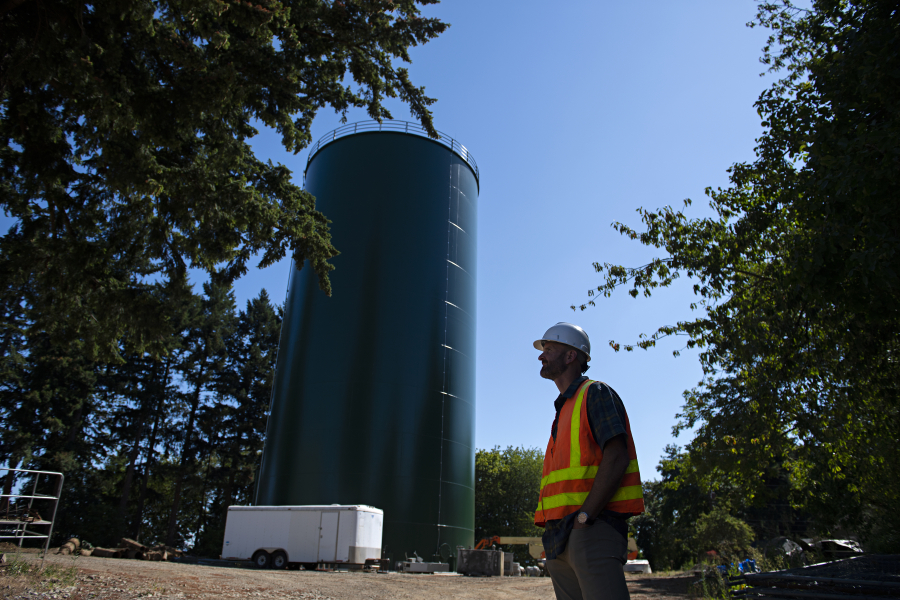If you’re a Vancouver resident, you may have received a mailer advising that your water contains “per- and polyfluoroalkyl substances,” otherwise known as PFAS – harmful human-made chemicals.
The four-letter acronym represents a class of thousands of substances, or “forever chemicals.” Like the nickname implies, they don’t break down in the environment or the human body.
Vancouver’s public water system, which serves roughly 78,000 customers, is one of many nationwide that have detected trace amounts of PFAS in its drinking water.
City officials are currently sampling at Vancouver water stations and expect to have results within two weeks of sending them to a lab. They will provide a public notice describing the results in March.
In 2020, the city of Vancouver found that several of its water stations had the contaminants. Sampling the following year showed that 36 of the city’s 40 wells contained some level of PFAS.
Some utilities in Washington with contaminated water may have an idea of where the chemicals come from – military bases, airports or any site that may have conducted training with firefighting foam.
In Vancouver and neighboring cities, the answer is murkier.
“There’s just no smoking gun that’s telling us where the source of this stuff is,” said Tyler Clary, Vancouver water engineering program manager. “It’s just so widespread throughout our service area and across our fields that we’re still trying to figure it out.”
Officials are navigating different potential sources, including landfills and stormwater, and say it’s likely a combination of factors.
“Unfortunately, we know we have it in our water,” Clary said. “At least we’re ahead of the curve and people are informed about it so they can make decisions on what they want to do about it.”
Clary said the city is determining whether its PFAS levels warrant treatment systems and, if pursued, what the cost would be and where the filters would be placed. However, treatment isn’t cheap, he said.
Concurrently, officials are developing a PFAS management plan to evaluate what water stations would take priority to be treated first, as well as what can be done until these systems are installed and operable.
Though PFAS quantities in Vancouver’s water exceed federal and state levels, this does not mean the water will make those who consume it sick – even those who have sensitive health conditions, according to the Washington Department of Health.
Community water systems that serve 25 or more customers are required to test for PFAS under a 2021 Washington State Board of Health rule.
Clark Public Utilities spokesperson Dameon Pesanti said the utility has not detected PFAS in its most susceptible wells, including Paradise Point, Hazel Dell and the Carol Curtis wellfield near Vancouver Lake. Those wells account for more than 75 percent of its water supply.
To check your public water source, visit Clark County’s online property information center.
What are PFAS?
PFAS are everywhere – food and wrappers, clothing, various household items, soil and water.
Producers use the chemicals to make items that resist heat, water, stain and oil, according to the Centers for Disease Control and Prevention. These properties make them ideal for outdoor gear, nonstick pans, cleaning products and cosmetics. Generally, exposure from PFAS in today’s goods are low compared with levels found in contaminated drinking water, according to the agency.
In short, it’s impossible to avoid the chemicals, and it remains unclear how they affect animals and human health.
The Department of Health reports that high PFAS exposure can lead to increased risks of thyroid disease and testicular and kidney cancer, as well as worsen cholesterol levels and immunity.
People can reduce their exposure to PFAS by limiting their consumption of contaminated food and water, install tap or well water filters and follow water advisories.
Bottled water can be used as an alternative water source, but it should be noted that some brands still contain PFAS, according to the Department of Health. For more general information and health advice, visit the agency’s PFAS webpage.
Larger initiative
Last week, the U.S. Environmental Protection Agency announced it would address PFAS in Washington’s drinking water with $33.5 million in grants available to small and disadvantaged communities.
It’s a small chunk of $5 billion stemming from the Bipartisan Infrastructure Law to be distributed across the country for drinking water sampling and PFAS mitigation.
EPA Region 10, which encompasses Alaska, Idaho, Oregon and Washington, will host a virtual meeting March 15 to share its PFAS strategic road map, as well as hear public feedback.
The road map was originally presented in October 2021 and, since its inception, released drinking water health advisories, provided a foundation for future PFAS testing and distributed funds to address water contamination in disadvantaged areas.
Lauren Ellenbecker: 360-735-4558; lauren.ellenbecker@columbian.com
About the project: Community Funded Journalism is a project from The Columbian and the Local Media Foundation that is funded by community member donations. The Columbian maintains editorial control over all content. For more information, visit columbian.com/cfj.




